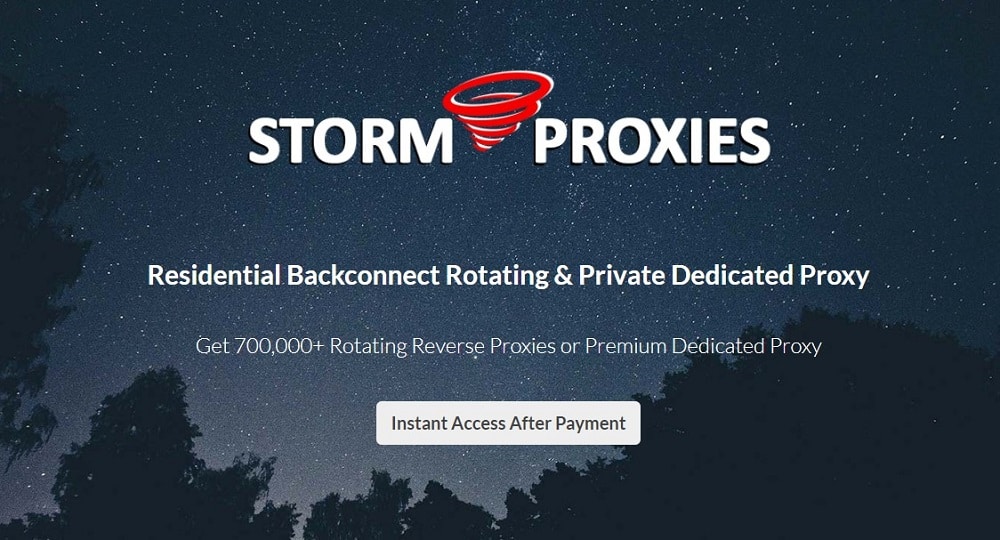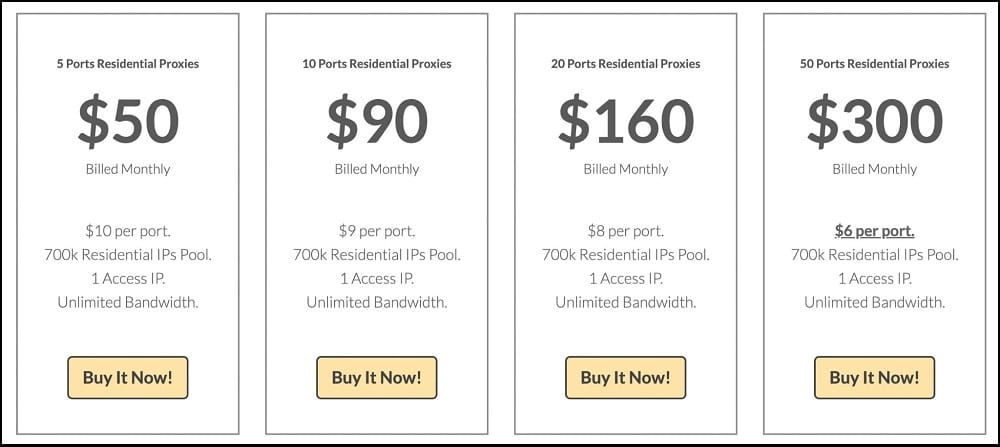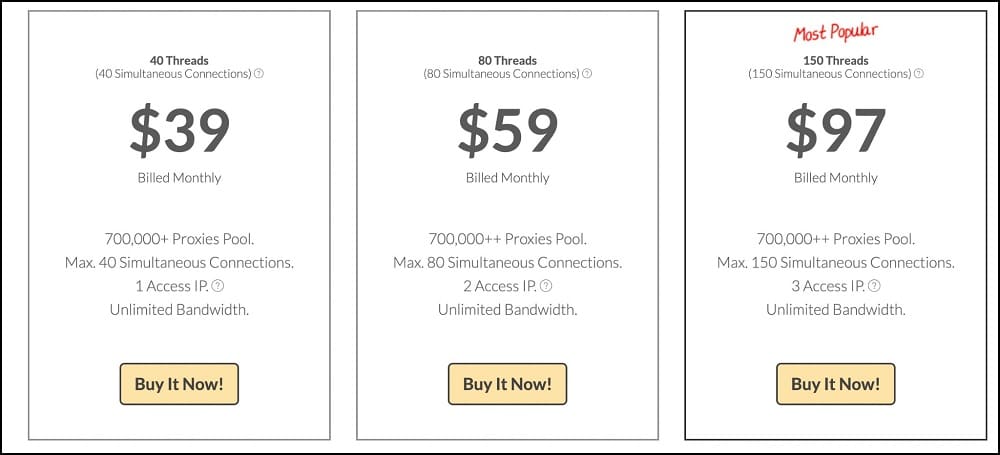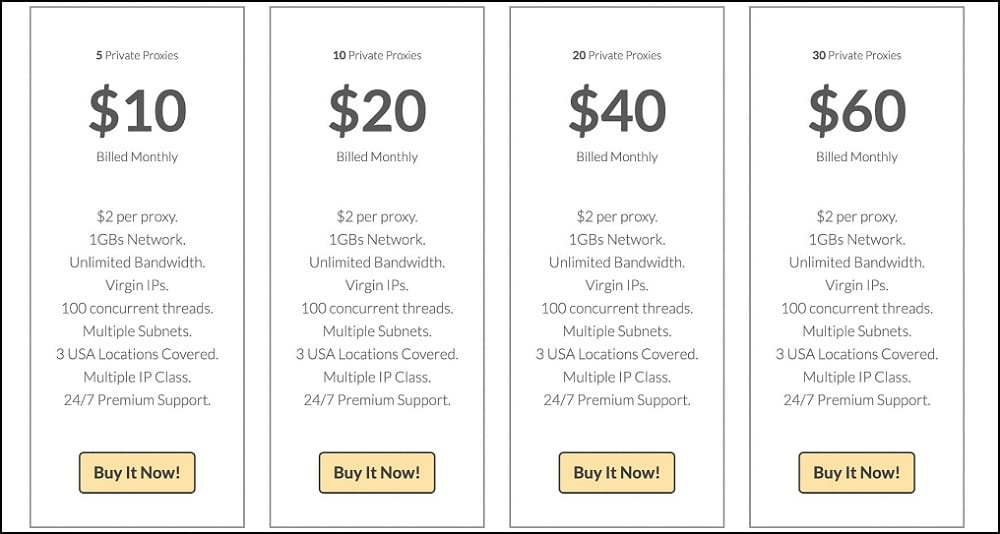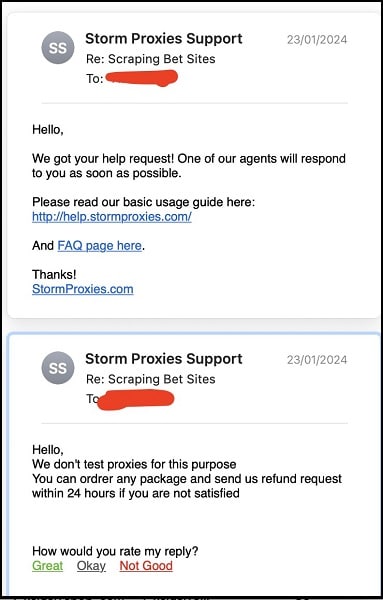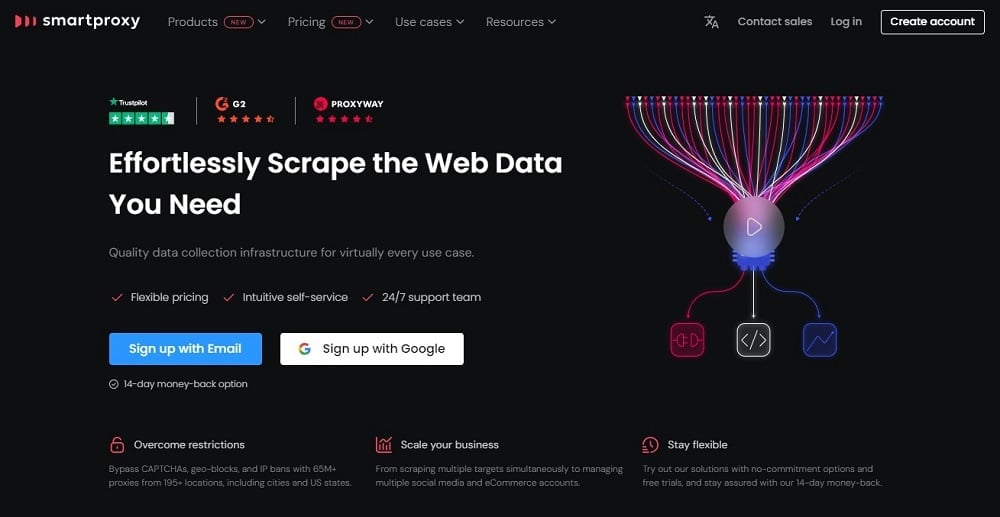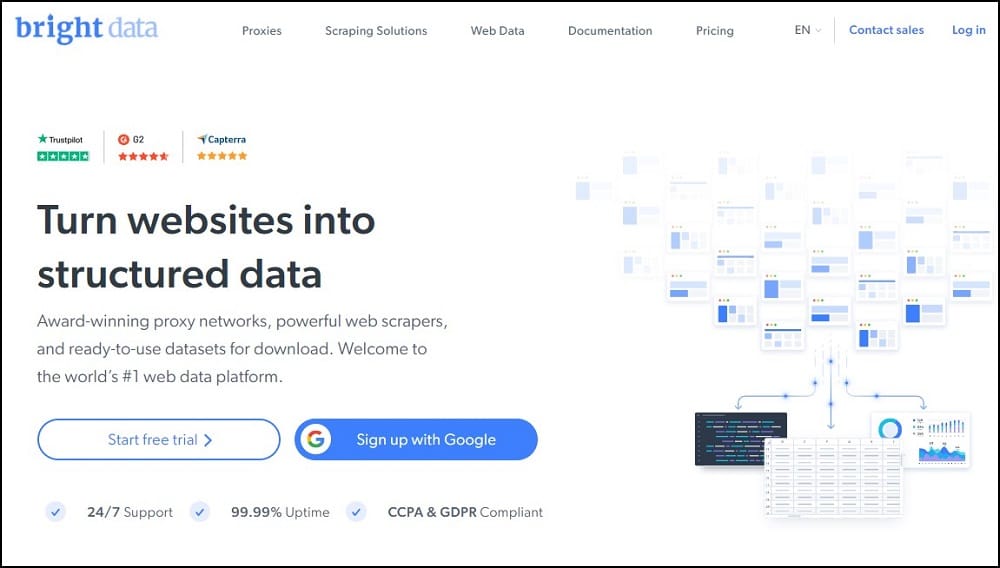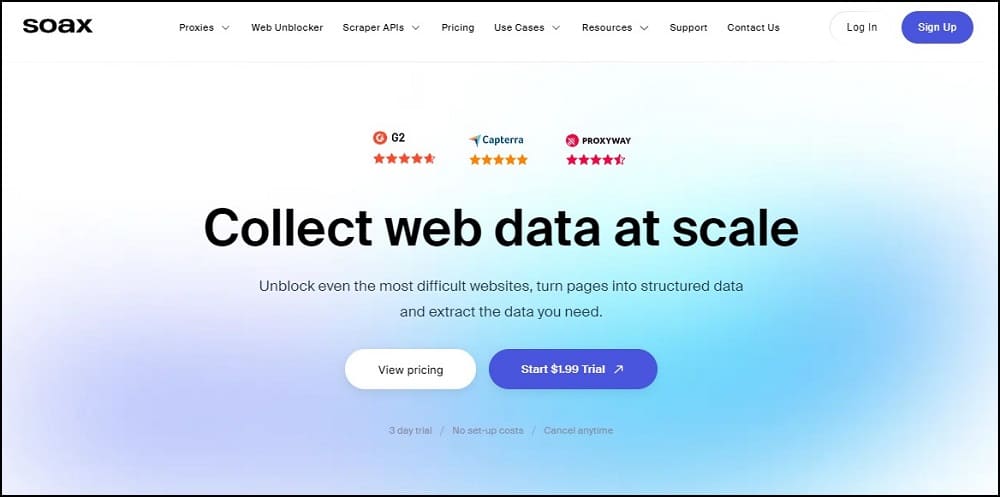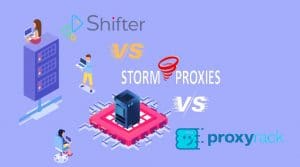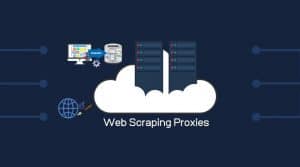Storm Proxies has been around in the proxy market for a long time, but they haven't been that active lately, so is it worth your investment? I believe you will have a wise decisionafter reading our latest review about it.
When I started reviewing proxies in 2020, Storm Proxies was one of the providers I knew then. I have also worked on a client web scraping project around the same period that I had to use these proxies.
Fast forward to January 2024, this same service is on my radar and I have to write a review of the Storm Proxies service. To be frank with you, this service has not changed over the years and their website looks dated. However, their promises and offerings still remain the same and then, they were a favourite because of their unlimited residential proxies.
Storm Proxies is one of the oldest surviving proxy providers and can be said to be reputable, considering its dealings over the years. It is based in the US and subject to the law there. This service is known for offering residential backconnect proxies and private datacenter proxies.
It is focused majorly on small proxy users and does not make any exaggerated promises — it offers proxies that just work. But as a proxy user, you don’t need proxies that just work, you need the ones that will work for your tasks. In this review, I seek to unveil their proxies and performance to help you decide whether their proxies will work for you or not.
| Parameter | Feature |
| IP Type | Residential/ Datacenter IPs |
| Price Charged | Ports |
| Price Sample | 5 Ports – $50 (Monthly) |
| Pool Of IPs | 70,000+ |
| Proxy Protocol | HTTP(S) |
| IP Rotation | Sticky Session (Time) |
| Filtering/Targeting | Countries |
| Authentication | IP Authentication |
| Speed | Slow |
| Free Trial | No |
| Refund Policy | 24 hours |
| Support | Email and Contact Form. |
| Jurisdiction Location | USA |
Proxy Types
The Storm Proxies service offers two major types of proxies — residential backconnect rotating and private datacenter proxies. In between these, they have a good number of proxy offerings specialized for specific tasks. Let’s take a look at the major ones below.
Residential IPs Rotating Proxies
Stormproxies’s residential proxies are rotating proxies that rotate IPs frequently. However, it is quite unique as it allows users to consume unlimited bandwidth while basing the pricing on a number of ports.
The pool size is quite small as it only contains over 700K IPs but considering their target audience are small proxy users, this number is enough. Because they switch IPs frequently, they are a good option for web scraping tasks and can also be used to power automation bots for small to mid-scale tasks.
In terms of pricing, your pricing starts from $50 for 5 ports at a price of $10 per port. The higher plans with more ports have cheaper pricing per port. And for smaller proxy users that need just one port, they can purchase one port at $19 for a month.
Aside from these regular residential proxies, they have specialized pools for some highly specific tasks. Some of these include sneaker copping and ticket scalping — and the minimum monetary commitment for these residential proxies is quite higher but with a cheaper cost per port.
IP rotation for each of the ports is after every 5 minutes which only makes sense if you rotate the individual ports together as waiting for one port to switch IPs for you will get you blocked for some tasks. From the user dashboard (member area as they call it), you can choose IPs from either US or EU locations.
Other locations are not supported. If you need a service that gives you more control over geo-targeting, then you need to take a look at the alternative section of the article at the end of it.
Datacenter IPs Rotating Proxies
These proxies are rotating proxies but use datacenter proxies. This is not common as most datacenter proxies are static proxies. For this, there is the option to switch IP after every request, 3 minutes or 15 minutes. Unlike in the case of its residential counterparts, you have the option to choose more locations including the US, EU, and a global pool.
However, you don’t have control over the specific countries either. These proxies too, can be sued for scraping, but your target shouldn’t be a site with strict anti-spam systems. They can be used for bulk account creation, brand protection, and ad verification.
Pricing for this is neither based on bandwidth nor ports but on the number of threads. It starts from $39 for 40 concurrent threads. There is also the option to pay $14 and get 10 threads for small users. However, the more threads you pay or the cheaper the price per thread. One advantage these rotating datacenter proxies have over their residential counterparts is that they are fast. However, they do have their downside which is them being easily detectable.
Dedicated Premium Private Proxies
These proxies are the regular datacenter proxies only that they are private and only you can make use of them for the period you paid for. In terms of location support, you only have the US as the supported country. If you need IPs for other regions, then Storm Proxies is not the provider for you.
The proxies here are some of the fastest they offer. Interestingly, the are the most affordable of them all. With just $10, you can purchase 5 proxies to use for a month. The higher plans cost and have more IPs but have a cheaper price per proxy.
While I use the word affordable for these proxies, they are not quite different from the average as $2 per proxy is the average. These proxies are used for tasks that require high performance in terms of speed — but shouldn’t be used on sites with strict anti-spam systems.
Residential Proxy Features
The Storm Proxies service is not the one you will be looking out for stellar features. However, it still does have the features that set it apart from others. Let’s take a look at some of these features.
Unlimited Bandwidth Usage
Residential proxies are known to have bandwidth limitations and that forms the basis of their pricing. However, when posed with a task that consumes a lot of bandwidth, this can quickly jerk your proxy cost up. Storm Proxies residential proxies allow you to enjoy unlimited bandwidth. This is great for scraping sites that will consume a lot of bandwidth. I have been involved in a scraping project that scrapes large JSON data. Without Storm Proxies, my cost would have been something else.
Sticky Port Support
Storm’s residential proxies rotate IPs for you, but the rotation is not high rotating, that is, it does not rotate IPs for you after every request — your IP is changed after 5 minutes. This makes it possible for you to use it as a session proxy or help you maintain sticky sessions.
But the session is short-lived as the IP will be changed after every 5 minutes. This is useful for short-term account management and tasks that require sessions such as in the case of the use of a traffic bot, sneaker copping, and ticket scalping. You can also use this for some small-scale web scraping.
Specifically for the US and EU
Storm Proxies does not support many locations. You can only get IPs for the US and EU. Even for the EU, you can’t choose the specific locations where you need IPs from. This means that unless your task requires IP from the EU or US, this service is not the best for you. However, if you have a small project and require IPs from the US or EU, then Storm Proxies can be a worthy option for you. However, there are better providers that give you more control over the geolocation of the IPs assigned to your requests.
Specialized Proxy Offering
If you take a look at their website, you will see that they do not just offer residential and datacenter proxies. There are some other proxies that come with the names of some specific tasks. These include sneakers proxies such as Nike proxies and Adidas proxies, ticketing proxies, and even social media proxies.
For these types of proxies, they still belong to either the residential or datacenter proxies class. However, they have been engineered to work best for specific tasks. If you check their pricing, you will see that they cost more because of this too.
Residential Proxy Performance
Now that you have an overview of the Storm Proxies residential proxies, it is time to get to the performance tests and results I got testing their back-connect residential proxies. Again, you need to remember that IPs do not get changed after every request but after 5 minutes.
Proxy IP Geo Test
Geolocation support is not one of the strengths of Storm Proxies. Unlike other providers that will claim to offer IPs in over 150 countries but in reality, the geo-targeting feature is only useful to a reasonable degree in less than 30 countries, this one does not make any claim of such.
In fact, there are major 2 locations you can choose IPs from using Storm Proxies geo-targeting feature —- the US and EU. You can choose whether you want US IP addresses, EU IP addresses, or a mix of both US and EU IP addresses. One issue I do have is the lack of control for locations even for the US and EU — you have to take what is provided to you.
For some users, this is not a problem, especially for tasks that do not require you to use IPs from specific locations. But if your task has a geo-location requirement and that geo-location is not US, then Storm Proxies is a flop here. Check, I didn’t mention the EU countries. This is because you don’t have control over the country you get the EU proxies.
Proxy Success Rate Test
Here I tried to test how many web scraping requests you send out of 100 will succeed and how many will fail. And in doing that, I try to stress-test, push it beyond the limit, and see how it will perform. To do this, I chose 10 popular targets, known to have some of the strongest anti-spam systems out there. The goal is to see how Storm Proxies perform on these sites as that can serve as a true benchmark to see how effective they can be. Below is the result of the test.
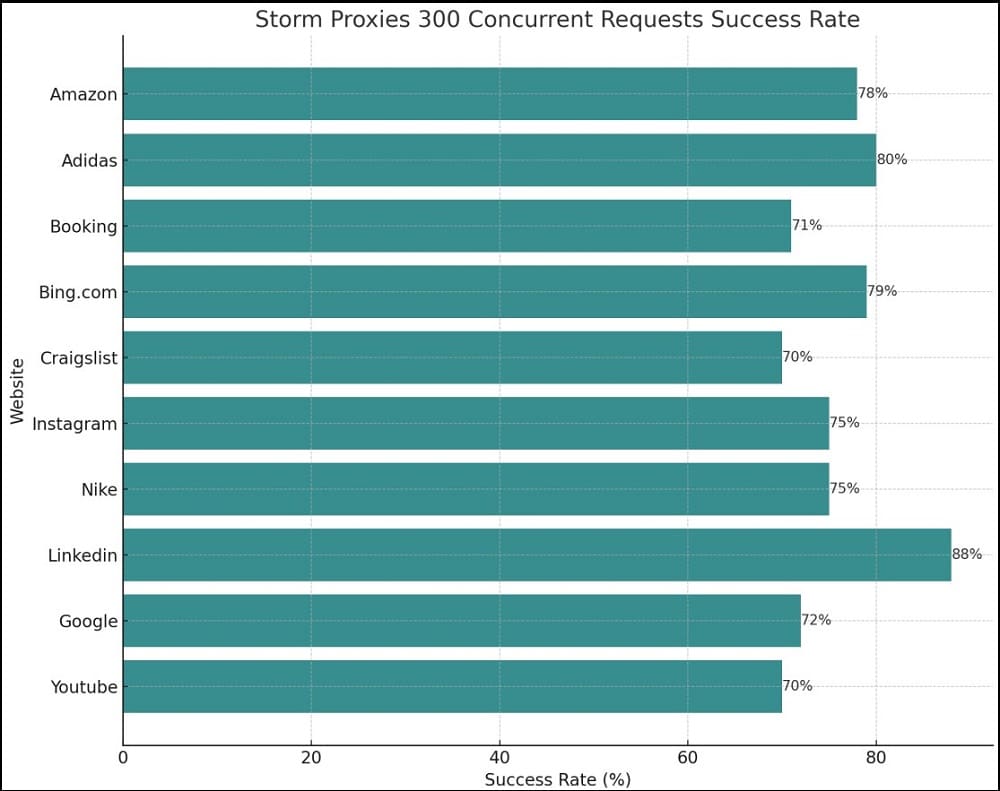
Average success rate: 75.8%
As you can see above, the average success rate is 75.8%. This is not an impressive number but this is close to something acceptable. This is because not all request failures are as a result of proxy issues. When it comes to scraping LinkedIn, the success rate recorded was 88% which is impressive. It also does well at scraping Amazon, Adidas, and Bing. However, Google, YouTube, Booking, and Craigslist seem to have got u with it as the success rate is around 70%.
There is one thing I want you to know here — 300 concurrent requests were sent here as I normally do in my reviews. Being a small proxy provider, this provider might not even be built for these. When fewer requests are sent concurrently, the success rate is higher.
Remember from the introductory section, I mentioned I have used this for web scraping in the past. The result then was better as I didn’t send 300 concurrent requests. Also important is the fact that it does not switch IPs for you after every but after 5 minutes. For this reason, these results are acceptable.
Response Time Test
Another test we carried out was the response time test. We wanted to see how fast their proxies respond as this goes a long way to determine how fast and quick you can complete your tasks using their proxies.
Unlike in the case of testing the success rate that we displayed the result on some targets, here, we would like to pair the result with that from other providers for you to see how fast their proxies are compared to other providers. Below is a summary of the response time test of Storm Proxies displayed with other popular providers.
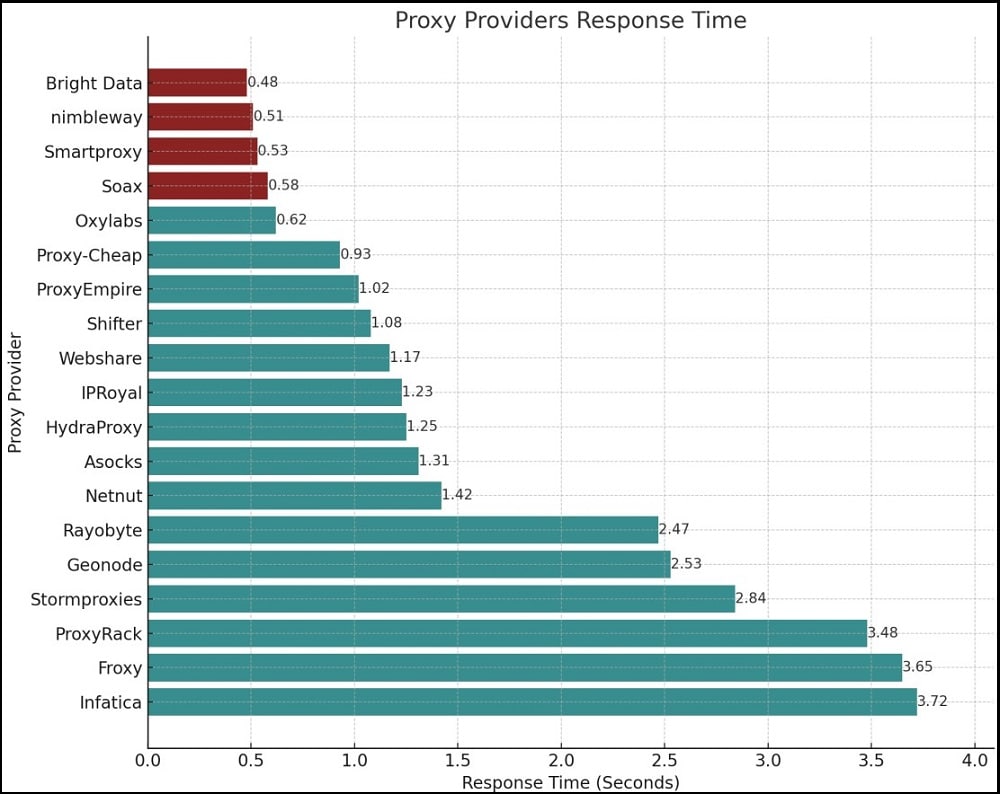
From the above, you can see the list of popular residential proxies including Storm Proxies, and their measured average response time. From the chart, you can tell Storm Proxies is at the bottom of the list. Looking at its measured value, it will take an average of 2.84 seconds for a request to return a response.
Will you term this fast or slow? For me, this is a really slow speed and if you have a daily large project, it will take a long time for you to finish up your scraping task. For faster providers, you can see Bright Data, Nimbleway, Smartproxy, and Soax at the top. Bright Data will even return a response in 0.48 seconds — more than 5 times faster than Storm Proxies.
Unique IP Test
Last for the performance test is the unique IP test. This is helpful for those who want to engage in web scraping as you need unique IPs to exceed limits and avoid getting blocked. For this, there is a major problem here — Storm Proxies does not offer high rotating proxies. That is, proxies do not switch IPs after every request. IP rotation is after every 5 minutes. To carry out this test, we needed to purchase multiple ports and then use and switch them. And below is the result we got.
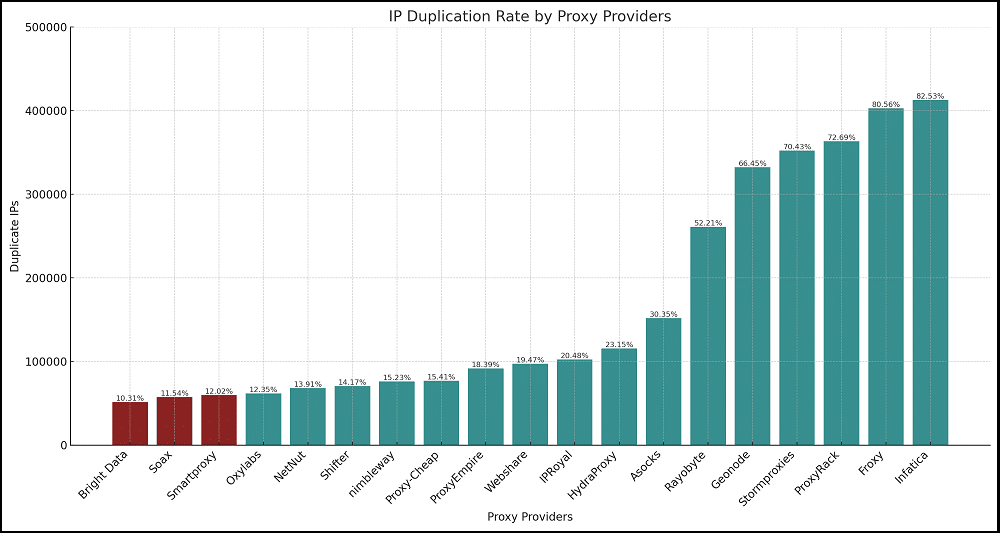
The IP duplicate rate for Storm Proxies from the chart above is 70.43%. This number is not surprising to me as it declares that it has only over 700K IPs. In fact, I will say it performs better than Geonode, Proxyrack, Froxy, and Infatica, all claiming to have millions of IPs in their pool but the IP duplicate rate is either at the rate of Storm Proxies or even worse.
You won’t get a new IP per request for this service. To get more newer IPs, you will need a bunch of ports from them and manually rotate between them. This is one of the reasons we don’t recommend you use their proxies for large projects as what it will take to work is a lot.
How to Use Storm Proxies
I have used Storm Proxies residential proxies twice — first as a web scraper and second, as a reviewer. Will I say their service is easy to use? Well, it depends on the aspect you are looking at. On a general level, it is easy to use. All you need is to log into the member area and get your proxy credentials which include proxy host and port. The Storm Proxies service does not support username and password authentication.
The only supported method for authentication is IP authentication — and the number of IPs that can be whitelisted depends on the plan you subscribe to. Another thing you wouldn’t find interesting is that it takes 10 minutes for a whitelisted IP to take effect. Also important is its lack of support for good geo-location targeting and its small pool. All of these come together to make it a poor service for most mid to large-scale projects.
Source of IPs
Storm Proxies as with other providers does not own the IPs in its pool. The IPs are sourced via P2P networks from the supported countries. However, the details of the P2P networks they use and how the IPs are sourced — whether legally or not are not made public. This is not something that can be found out easily.
But some providers that know the source of their IPs to be ethical including Netnut, Bright Data, and even Rayobyte make this information public as a thing of pride. The likes of Sorm Proxies do not even want to talk about it. While we can’t say whether the source of their IPs is ethical or not, we do know they don’t want the real details out there.
Customer Support
If you are the type that cares about customer support and the swiftness of their response then Storm Proxies might be a turn-off for you. First of all, this service does not offer live chat support. Storm Proxies delivers support to their customers via emails. Yes, you will see a chat feature but when you click it, it will be supported via email. Well, I made use of this, sent a message at around 10:17 AM, and got back a response around 5:51 PM.
That is some 7 hours of waiting time to get a response from support. Are these hours something you can deal with? For a service that has been around for a while now, customer support should be one thing they have mastered, but I can say they haven’t done that yet.
Do We Recommend Storm Proxies
Storm Proxies is one of the oldest providers, so it does have a reputation and is not out to scam you. It is one of the pioneers of the unlimited residential proxies. I do like the idea of having specialized proxies for specific tasks such as sneaker copping, ticket scalping, and social media automation and management.
However, the performance isn’t great enough to be recommended for large projects. Storm Proxies at best, should be used for mid-scale projects looking to purchase cheap proxies. We recommend it more for small-scale projects.
Alternatives to Storm Proxies
Below are some of the alternatives to the Storm Proxies service you can use.
Smartproxy — Recommended for high concurrency.
There is a limit to the number of threads you can create at a time with Storm Proxies. The Smartproxy service, on the other hand, allows you to create as many concurrent threads as you like. It generally offers you better performance, more expensive location support, and a high success rate. It is affordable, too.
Bright Data — Recommended for the highest success rate for web scraping.
If your project is a scraping project, you can’t go wrong by choosing Bright Data. It has a large proxy pool, offers more unique IPs than any other provider, and is also the fastest. You can get IPs for any location in the world for geo-based scraping. These and many more make it the best alternative for web scraping.
Soax — Recommended for a higher success rate.
This service has one of the cleanest pools in the market. This makes its success rate high making it the choice for serious projects where you want to keep failure rates and retries as small as possible. However, it can be expensive as it minimum monetary commitment is $99.
Our Expert's Review
-
Scaping Performance - 7/10
7/10
-
Proxy Network - 8/10
8/10
-
Proxy Functions - 8.3/10
8.3/10
-
Customer support - 7.1/10
7.1/10
Read other user reviews

